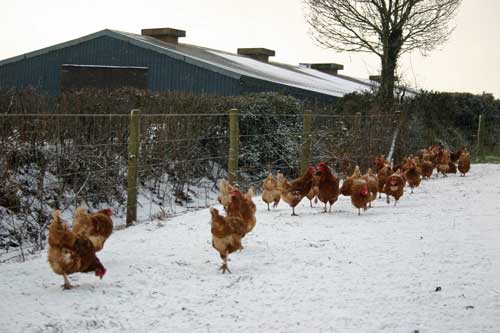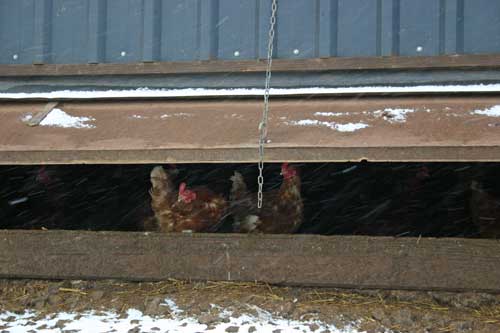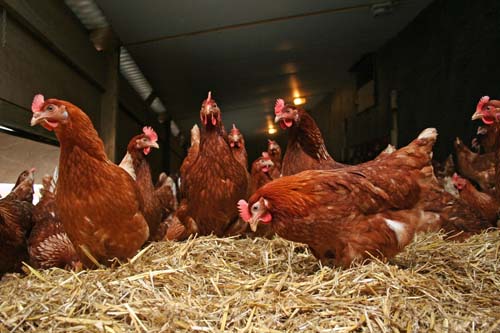
This is the time of year when some free range egg producers are able to thank their lucky stars that the hens are in warm and dry houses. Oh, are they? Not everyone keeps hens in large houses. What about the mobile ones? Not all hens are able to escape the weather. I have written in the past about summertime problems. In the winter a different range of problems exists. What are they and can the effects of inclement weather on any of them be reduced?
Areas for Discussion:
1. Access to the range
2. Dirty wet litter and clean
eggs

3. Ammonia and ventilation
4. Environmental temperature
5. Feed consumption and
quality

6. Lighting patterns
Access to the Range area
In the summer, there can be a rush of hens onto the range area when the pop-holes are opened. When it is cold, windy and wet, there is less enthusiasm by the hens (and humans) to get outside. Cold winds –"they don’t like it up ’em"!!.
Obviously I do not advocate contravening the regulations about access to the range and the requirement for pop-holes to be open. However there are some cold and windy days when I do feel that the welfare of the hens is at risk by a rigid adherence to the regulations. Sometimes free range egg production is stressful and a good example of an avoidable stressor is a cold easterly wind blowing at floor level into the house via the pop-holes. As so few hens adventure out of the house on really inclement days, it seems sensible to reduce the floor draughts by leaving some chosen pop-holes shut. They should all be open however on the other side of the house. I am in favour of regulations provided that they can be used flexibly when the welfare of the hens is in jeopardy.
In theory a small wind-break could be erected outside the house to divert the airflow away from chosen pop-holes but as there needs to be an area of stones or weldmesh where the wind-break would need to be, this may not be practicable.
Dirty, wet litter / clean eggs
Even in warm broiler houses in the winter, the litter can lose its friability and become capped in some areas. Research has shown that the main reason for this is an increase in moisture in the litter to the point where the friability is lost and it develops a cap / crust on top of it. In practice, the litter loses its friability when the moisture content of the litter exceeds about 46%.
For free range egg producers the same principles apply. If you handle litter that is friable, it should be slightly warm. That is because of the breakdown of the faeces in the litter by bacteria. When the litter gets cold, the bacterial breakdown diminishes. When the litter is cold and wet the bacterial activity is minimal. The moisture content of faeces as it leaves the hens is about 70%. The moisture of the faeces has to be reduced if there is any chance of having a good litter quality. In theory therefore, the litter should be kept warm and dry. What a problem in the winter! Can anything be done? Yes, but it is still a difficult problem. Try the following suggestions.
a) Ensure that after the hens have been on the range area, they can "wipe their feet" before entering the house onto the litter area. Round stones and/or weld-mesh on frames can help with this.
b) The success of free range egg production depends on the production of clean eggs. By trying to get the hens’ feet clean when they come into the house and then continuing to clean them further as they walk onwards across the litter and slats to the nests, the chances are improved of getting clean eggs.
c) Dry, white woodshavings are likely to be the most successful for keeping litter friable. If straw is used it must be chopped so as to increase its ability to absorb moisture. The whole point about straw when growing in the field is that it repels water.
Therefore using unchopped straw does not make a good substrate for litter. It discourages the bacterial activity that is necessary and is likely to end up as a mess. Don’t forget to make insoluble, turkey sized (flint or granite) grit available to the hens, so that they can digest any litter that they may eat.
d) Be proactive with litter management. Add new litter as necessary and although it is a chore, stirring it can help at times when the humidity in the house is low and ventilation generous. This is especially useful in the spring when it is getting warmer.
e) Things that would be likely to work such as underfloor heating, installed when the house was built, could be considered. Unfortunately considering it wouldn’t take long, because the costs would presumably be prohibitive! Has anyone any bright ideas how this could be made cost effective?
Ammonia, ventilation and environmental temperature
Hens give off moisture both in the faeces and in their breath. In the winter added to this is the cold and humid external air. This makes ventilation control difficult. For caged hens it has long been known that the optimum temperature within the house is 21°C (70°F). In most free range houses, this is a virtually impossible aim in the winter. The number of hens is too low in relation to the total cubic area of the house. Therefore it is inevitable that the internal temperature will fall, unless the air inlets in the houses restrict the airflow. Restricting the ventilation could be a bad idea because ammonia will rise. Ammonia depresses the feed intake of the hens. A reduced nutrient intake will lead to a reduction in egg size, possibly numbers too and therefore in income. In addition ammonia can inflame the trachea (wind pipe) in the hens and make them more susceptible to respiratory diseases.
You can see therefore that ammonia, ventilation, temperature and litter condition are all interdependent. All are important, so how do we know how to prioritise them? In my view, ammonia is the one to get right first. Do not let it get to the concentration that brings tears to your eyes. If you who are in the house daily think that it is a bit smelly, it is! It would almost certainly be above the permissible 25ppm threshold. How about investing in equipment to check the ammonia concentration in the free range house? It is available and not prohibitively expensive. So controlling ammonia is important even if it means letting the temperature drop. In practice, it is then a question of aiding litter quality by whatever means seem to be productive.
Feed consumption and quality
During the past 20 years there have been discussions about whether there should be a wintertime / summertime feeding regime. I agree with those who say that it is neither necessary nor practicable. A well-managed phased feeding regime can be and is successful. Provided that each feed in the programme is iso-caloric i.e. has the same medium Metabolisable Energy of about 11.5 MJ/kg, the hens will adjust their feed intake to take account of the temperature. The graphs (shown over the page) show the relationship between temperature and feed consumption and the egg weight.
The higher winter time feed consumption should lead to an increase in the egg size. As the price structure for free range eggs encourages the production of large eggs (ideally more than 63 g but less than 73 g), wintertime should not add to any problems that are related to the feed. The possibility exists that the summertime ones are smaller than they ideally should be. That is not a big problem however if the timing of feed changes is correct and is flexible.
Light patterns
Wintertime has its disadvantages but a big advantage however is that a suitable lighting programme can be imposed on pullets that are delivered at this time of year. The pullets that are delivered to you will presumably have been on a 10 hour daylength. You are able to continue with 10 hours / day until the pullets have reached their optimal livew
